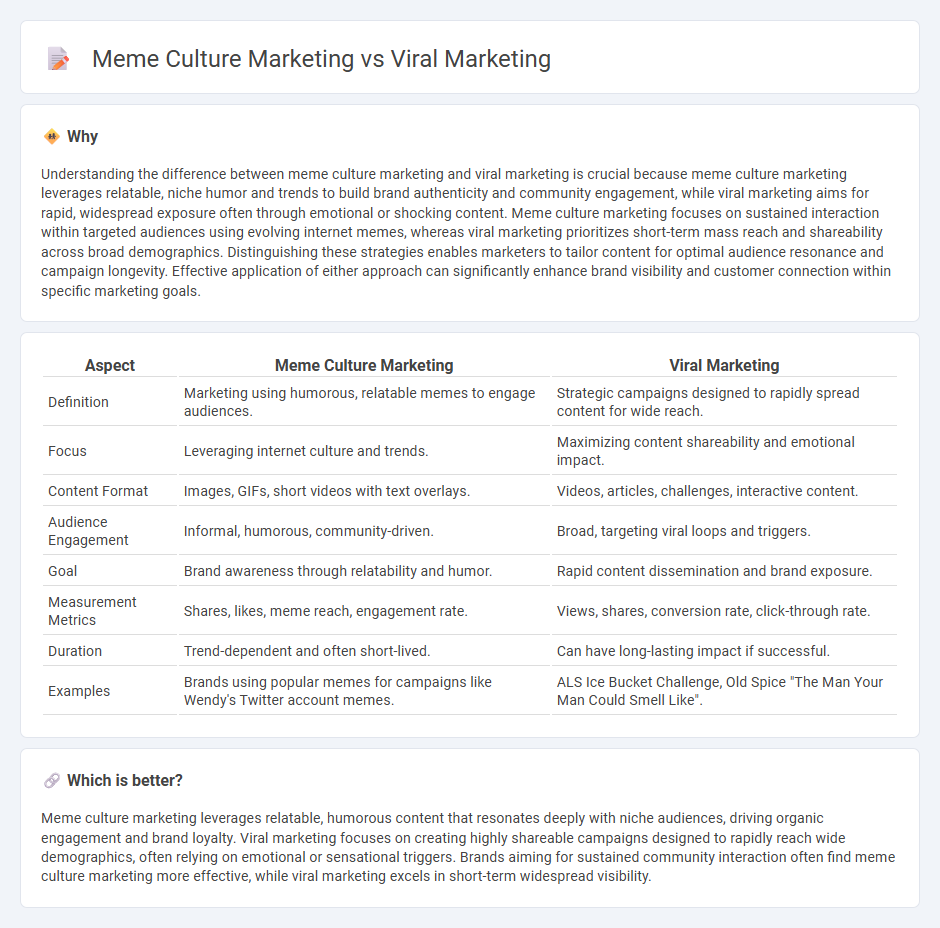
Meme culture marketing leverages humor and relatable content to engage niche audiences quickly, creating organic brand awareness through shareable images, videos, and trends on social media platforms. Viral marketing focuses on crafting compelling messages designed to rapidly spread across diverse channels, maximizing reach and impact through emotional triggers and strategic timing. Explore the unique strategies behind meme culture and viral marketing to elevate your brand's digital presence.
Why it is important
Understanding the difference between meme culture marketing and viral marketing is crucial because meme culture marketing leverages relatable, niche humor and trends to build brand authenticity and community engagement, while viral marketing aims for rapid, widespread exposure often through emotional or shocking content. Meme culture marketing focuses on sustained interaction within targeted audiences using evolving internet memes, whereas viral marketing prioritizes short-term mass reach and shareability across broad demographics. Distinguishing these strategies enables marketers to tailor content for optimal audience resonance and campaign longevity. Effective application of either approach can significantly enhance brand visibility and customer connection within specific marketing goals.
Comparison Table
| Aspect | Meme Culture Marketing | Viral Marketing |
|---|---|---|
| Definition | Marketing using humorous, relatable memes to engage audiences. | Strategic campaigns designed to rapidly spread content for wide reach. |
| Focus | Leveraging internet culture and trends. | Maximizing content shareability and emotional impact. |
| Content Format | Images, GIFs, short videos with text overlays. | Videos, articles, challenges, interactive content. |
| Audience Engagement | Informal, humorous, community-driven. | Broad, targeting viral loops and triggers. |
| Goal | Brand awareness through relatability and humor. | Rapid content dissemination and brand exposure. |
| Measurement Metrics | Shares, likes, meme reach, engagement rate. | Views, shares, conversion rate, click-through rate. |
| Duration | Trend-dependent and often short-lived. | Can have long-lasting impact if successful. |
| Examples | Brands using popular memes for campaigns like Wendy's Twitter account memes. | ALS Ice Bucket Challenge, Old Spice "The Man Your Man Could Smell Like". |
Which is better?
Meme culture marketing leverages relatable, humorous content that resonates deeply with niche audiences, driving organic engagement and brand loyalty. Viral marketing focuses on creating highly shareable campaigns designed to rapidly reach wide demographics, often relying on emotional or sensational triggers. Brands aiming for sustained community interaction often find meme culture marketing more effective, while viral marketing excels in short-term widespread visibility.
Connection
Meme culture marketing leverages humor and relatable content to engage audiences, creating highly shareable material that fuels viral marketing campaigns. Viral marketing relies on rapid content dissemination across social media platforms, often driven by memes that resonate culturally and generate organic reach. Brands successfully combining these strategies amplify message visibility and consumer interaction through authentic, user-generated sharing.
Key Terms
Word-of-Mouth
Viral marketing leverages strategic content designed to rapidly spread across social networks, amplifying brand visibility through exponential shares and engagement. Meme culture marketing taps into popular internet humor and trends, fostering authentic word-of-mouth promotion by resonating with niche online communities and encouraging user-generated content. Explore deeper insights into how word-of-mouth drives consumer behavior in both viral and meme culture marketing strategies.
Shareability
Viral marketing leverages emotionally engaging content to rapidly amplify brand messages across social networks, driving exponential shareability through compelling storytelling and strong calls to action. Meme culture marketing exploits humor, relatability, and current internet trends to encourage organic sharing, fostering authentic audience connections with minimal promotional overtone. Explore how combining these strategies can maximize your campaign's reach and impact.
Internet Trends
Viral marketing leverages rapid spread of content through social sharing to maximize brand visibility, while meme culture marketing taps into relatable, humorous memes aligned with current Internet trends, fostering genuine audience engagement. Both strategies capitalize on digital platforms but differ in content style and audience interaction dynamics, with meme marketing relying heavily on cultural relevance and informal communication. Explore how integrating these tactics can amplify your online presence and resonate with target demographics more effectively.
Source and External Links
Viral marketing - Wikipedia - Viral marketing is a business strategy that uses existing social networks to promote products primarily through social media, relying on consumers to spread messages like a virus through word of mouth and network effects online.
Viral Marketing: Advantages, Disadvantages, Examples and FAQs - Viral marketing uses captivating, share-worthy content to rapidly spread a message via social media and word of mouth, aiming for exponential reach by motivating users to voluntarily share within their networks.
What is Viral Marketing? | Directive - Viral marketing is a digital strategy focused on creating content with a high likelihood of being organically shared by people with extensive social networks, enabling rapid, wide distribution without paid ads.
 dowidth.com
dowidth.com